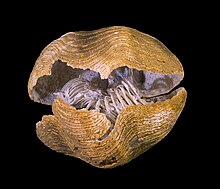Lophophor
Lophophores are tentacle-covered wreath or arm-like organs that are primarily part of the nutritional apparatus. They are also known as a tentacle wreath . Lophophores are characteristic of the groups of organisms Brachiopoda , Bryozoa , Entoprocta and Phoronida . Lophophores are only found in aquatic creatures. The Lophophor is ring-shaped, horseshoe-shaped or spiral. The synchronized beat pattern of the tentacles creates a flow of water that carries food particles to the mouth. The anus is always located outside the ring when the lophophore is in a ring.
Animals with lophophores are summarized as Lophophoraten, in German wreath probe (also: Tentaculata), a meanwhile outdated classification as an animal strain. According to the current system, their representatives are counted among the Lophotrochozoa .
etymology
Lophophor is derived from gr. Lophos (tuft, crest , tuft) and -phor , -phoros (φορος) (carrier), a derivation of phérein (φέρειν) (to wear); the meaning is therefore: tuft carrier .
supporting documents
- ↑ Archived copy ( Memento of the original dated December 16, 2005 in the Internet Archive ) Info: The archive link has been inserted automatically and has not yet been checked. Please check the original and archive link according to the instructions and then remove this notice. See under moss animals. Page last visited: December 21, 2010.
literature
- T. Kuzmina, V. Malakov: Structure of the brachiopod lophophore. In: Paleontological Journal. 41, no. 5, 2007, pp. 520-536.
- Keith Reingold: The role of the lophophore in feeding ecology of the fresh-water bryozoa. Dissertation . Dayton (Ohio) 1976, OCLC 2750758 .

